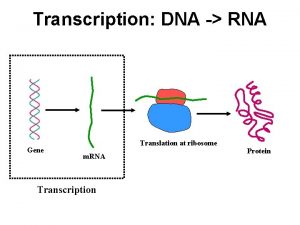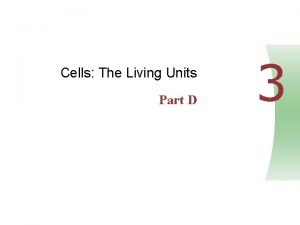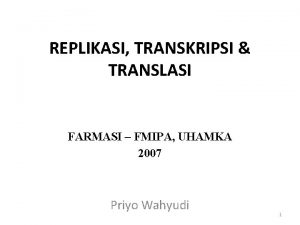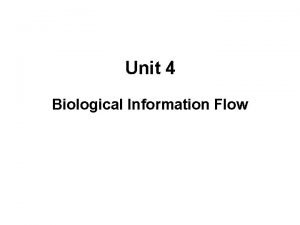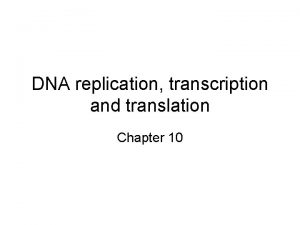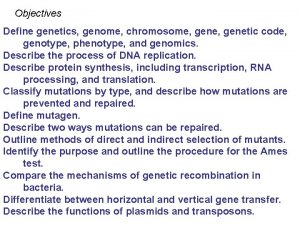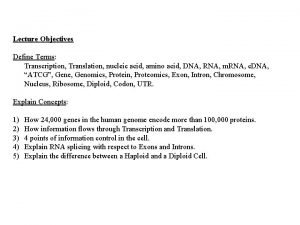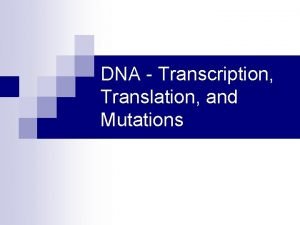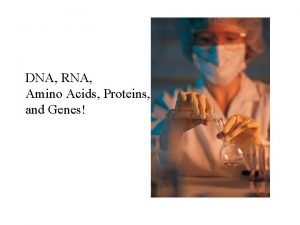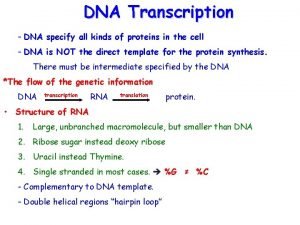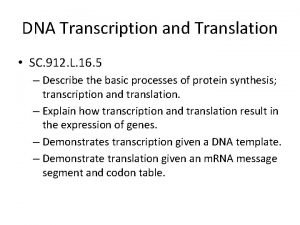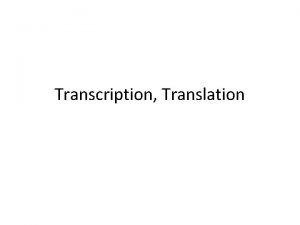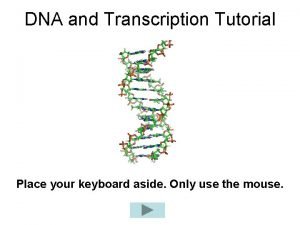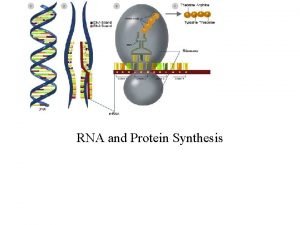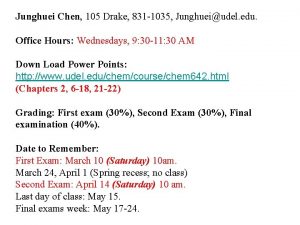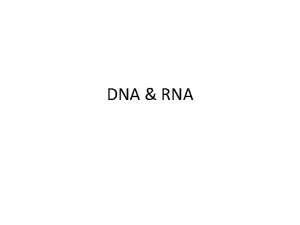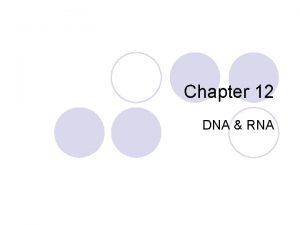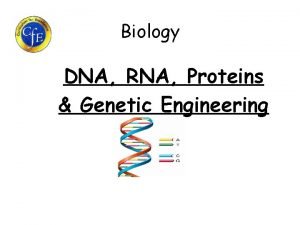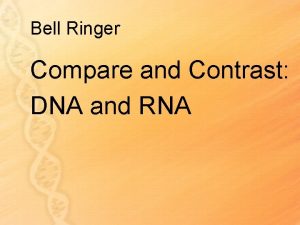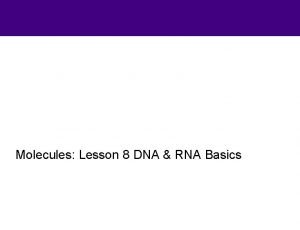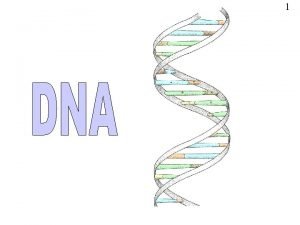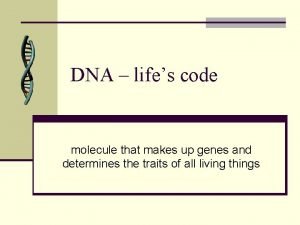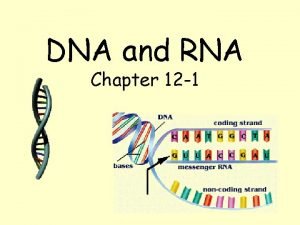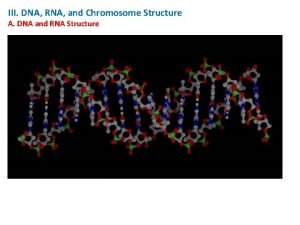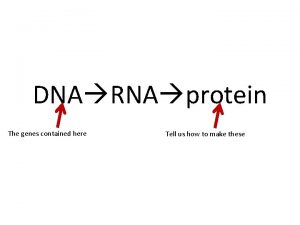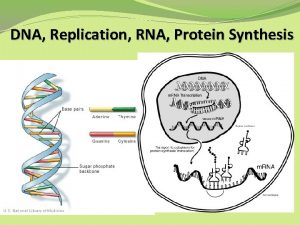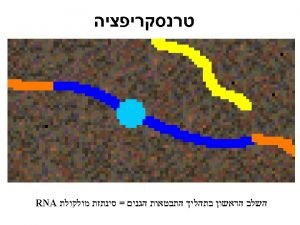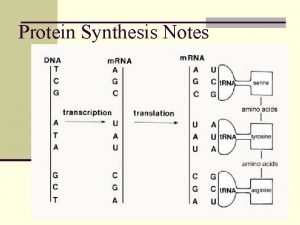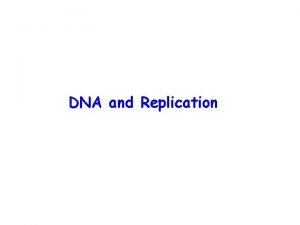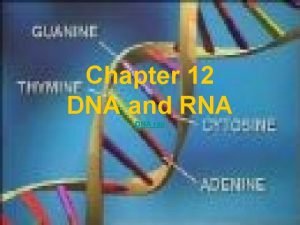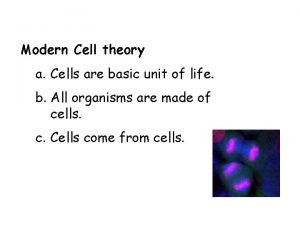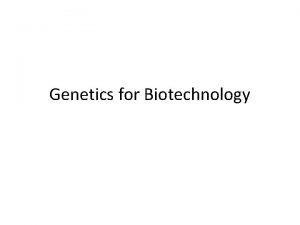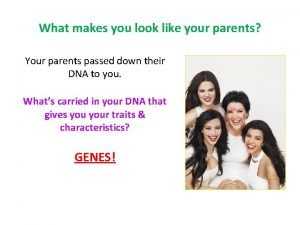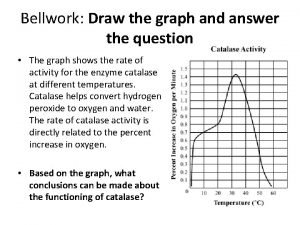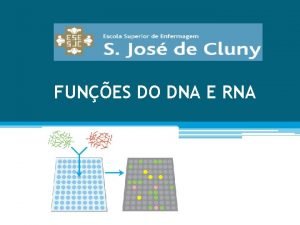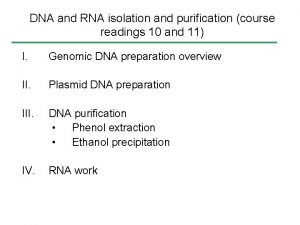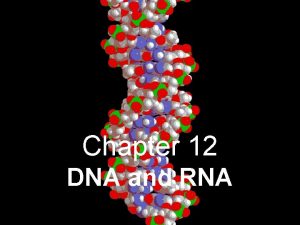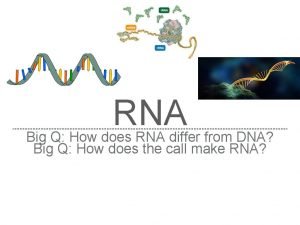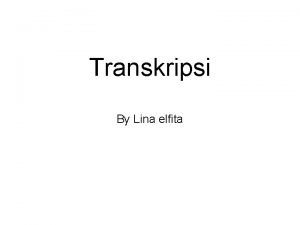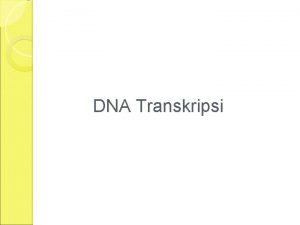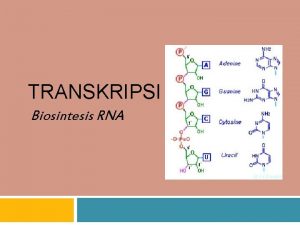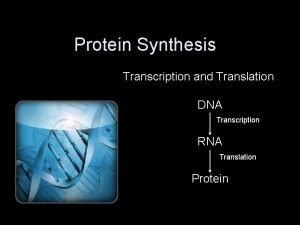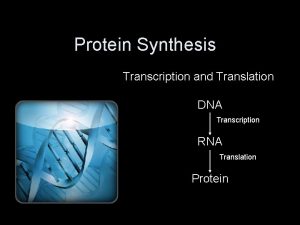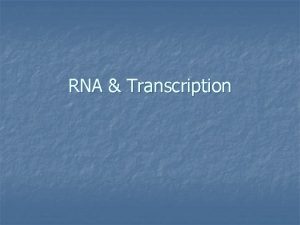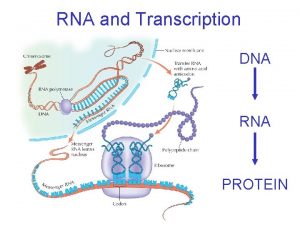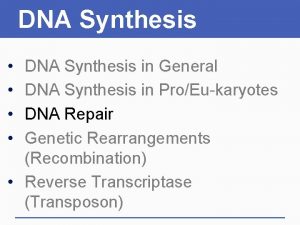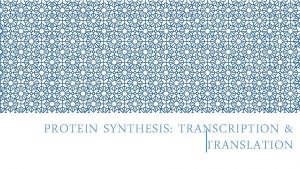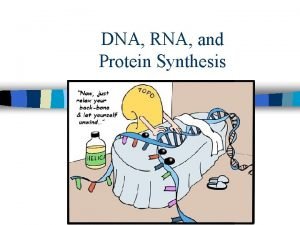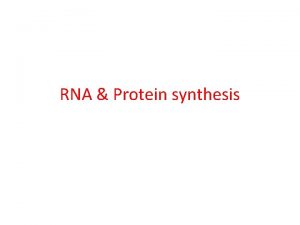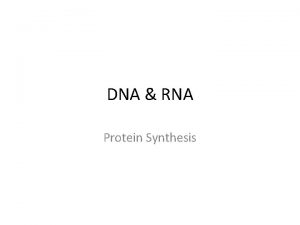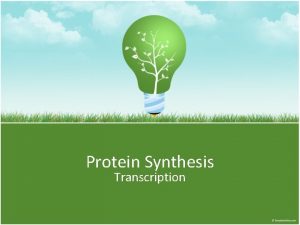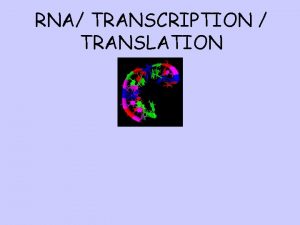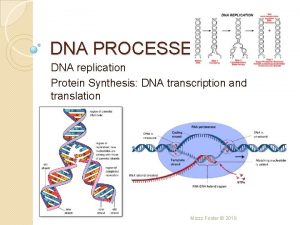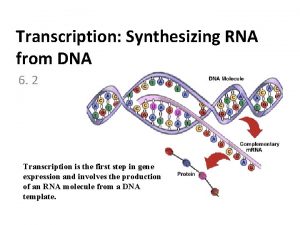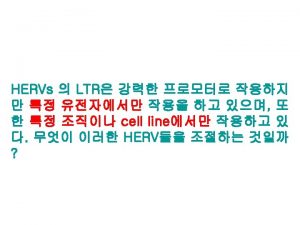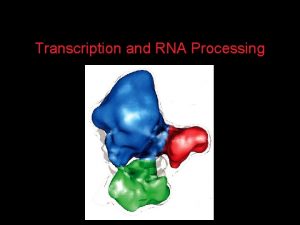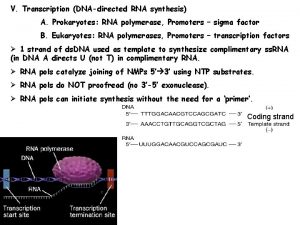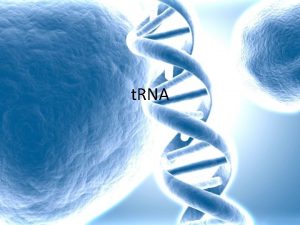DNA Transkripsi Transcription The synthesis of RNA molecules





















































- Slides: 53

DNA Transkripsi

Transcription The synthesis of RNA molecules using DNA strands as the templates so that the genetic information can be transferred from DNA to RNA.

Similarity between replication and transcription Both processes use DNA as the template. Phosphodiester bonds are formed in both cases. Both synthesis directions are from 5´ to 3´.

Differences between replication and transcription replication transcription template double strands single strand substrate d. NTP primer yes no Enzyme DNA polymerase RNA polymerase product ds. DNA ss. RNA base pair A-T, G-C A-U, T-A, G-C

The whole genome of DNA needs to be replicated, but only small portion of genome is transcribed in response to the development requirement, physiological need and environmental changes. DNA regions that can be transcribed into RNA are called structural genes.

Template The template strand is the strand from which the RNA is actually transcribed. It is also termed as antisense strand. The coding strand is the strand whose base sequence specifies the amino acid sequence of the encoded protein. Therefore, it is also called as sense strand.


Asymmetric transcription • Only the template strand is used for the transcription, but the coding strand is not. • Both strands can be used as the templates. • The transcription direction on different strands is opposite. • This feature is referred to as the asymmetric transcription.

RNA Polymerase The enzyme responsible for the RNA synthesis is DNA-dependent RNA polymerase. ◦ The prokaryotic RNA polymerase is a multiple-subunit protein of ~480 k. D. ◦ Eukaryotic systems have three kinds of RNA polymerases, each of which is a multiple-subunit protein and responsible for transcription of different RNAs.

Holoenzyme The holoenzyme of RNA-pol in E. coli consists of 5 different subunits: 2 .

RNA-pol of E. Coli subunit MW function 36512 Determine the DNA to be transcribed 150618 Catalyze polymerization 155613 Bind & open DNA template 70263 Recognize the promoter for synthesis initiation

Rifampicin, a therapeutic drug for tuberculosis treatment, can bind specifically to the subunit of RNA -pol, and inhibit the RNA synthesis. RNA-pol of other prokaryotic systems is similar to that of E. coli in structure and functions.

RNA-pol of eukaryotes RNA-pol I II III products 45 S r. RNA hn. RNA 5 S r. RNA t. RNA sn. RNA Sensitivity to Amanitin No high moderate Amanitin is a specific inhibitor of RNA-pol.

Recognition of Origins Each transcriptable region is called operon. One operon includes several structural genes and upstream regulatory sequences (or regulatory regions). The promoter is the DNA sequence that RNA-pol can bind. It is the key point for the transcription control.

Promoter

Prokaryotic promoter Consensus sequence

General concepts Three phases: initiation, elongation, and termination. The prokaryotic RNA-pol can bind to the DNA template directly in the transcription process. The eukaryotic RNA-pol requires co-factors to bind to the DNA template together in the transcription process.

Transcription of Prokaryotes Initiation phase: RNA-pol recognizes the promoter and starts the transcription. Elongation phase: the RNA strand is continuously growing. Termination phase: the RNA-pol stops synthesis and the nascent RNA is separated from the DNA template.

Initiation RNA-pol recognizes the TTGACA region, and slides to the TATAAT region, then opens the DNA duplex. The unwound region is about 17 1 bp.

The first nucleotide on RNA transcript is always purine triphosphate. GTP is more often than ATP. The ppp. Gp. N-OH structure remains on the RNA transcript until the RNA synthesis is completed. The three molecules form a transcription complex. RNA-pol ( 2 ) - initiation DNA - ppp. Gp. NOH 3

No primer is needed for RNA synthesis. subunit falls off from the RNA-pol once the first 3 , 5 phosphodiester bond is formed. The core enzyme moves along the DNA template to enter the elongation phase.

Elongation • The release of the subunit causes the conformational change of the core enzyme. The core enzyme slides on the DNA template toward the 3 end. • Free NTPs are added sequentially to the 3 -OH of the nascent RNA strand.

• RNA-pol, DNA segment of ~40 nt and the nascent RNA form a complex called the transcription bubble. • The 3 segment of the nascent RNA hybridizes with the DNA template, and its 5 end extends out the transcription bubble as the synthesis is processing.

Transcription bubble

RNA-pol of E. Coli

RNA-pol of E. Coli



Simultaneous transcriptions and translation

Termination The RNA-pol stops moving on the DNA template. The RNA transcript falls off from the transcription complex. termination occurs in either dependent or -independent manner. The

The termination function of factor The factor, a hexamer, is a ATPase and a helicase.

-independent termination • The termination signal is a stretch of 30 -40 nucleotides on the RNA transcript, consisting of many GC followed by a series of U. • The sequence specificity of this nascent RNA transcript will form particular stem-loop structures to terminate the transcription.


Stem-loop disruption The stem-loop structure alters the conformation of RNA-pol, leading to the pause of the RNA-pol moving. Then the competition of the RNARNA hybrid and the DNA-DNA hybrid reduces the DNA-RNA hybrid stability, and causes the transcription complex dissociated. Among all the base pairings, the most unstable one is r. U: d. A.

Transcription of Eukaryotes a. Initiation Transcription initiation needs promoter and upstream regulatory regions. The cis-acting elements are the specific sequences on the DNA template that regulate the transcription of one or more genes.

Cis-acting element

TATA box

Transcription factors RNA-pol does not bind the promoter directly. RNA-pol II associates with six transcription factors, TFII A - TFII H. The trans-acting factors are the proteins that recognize and bind directly or indirectly cis-acting elements and regulate its activity.

TF for eukaryotic transcription

Pre-initiation complex (PIC) TBP of TFII D binds TATA TFII A and TFII B bind TFII D TFII F-RNA-pol complex binds TFII B TFII F and TFII E open the ds. DNA (helicase and ATPase) TFII H: completion of PIC

Phosphorylation of RNA-pol TF II H is of protein kinase activity to phosphorylate CTD of RNA-pol. (CTD is the C-terminal domain of RNA-pol) Only the p-RNA-pol can move toward the downstream, starting the elongation phase. Most of the TFs fall off from PIC during the elongation phase.

b. Elongation The elongation is similar to that of prokaryotes. The transcription and translation do not take place simultaneously since they are separated by nuclear membrane.

nucleosome RNA-Pol moving direction RNA-Pol

c. Termination • The termination sequence is AATAAA followed by GT repeats. • The termination is closely related to the post-transcriptional modification.



m. RNA splicing m. RNA DNA The matured m. RNAs are much shorter than the DNA templates.

Split gene The structural genes are composed of coding and non-coding regions that are alternatively separated. A B C D E F G

Exon and intron Exons are the coding sequences that appear on split genes and primary transcripts, and will be expressed to matured m. RNA. Introns are the non-coding sequences that are transcripted into primary m. RNAs, and will be cleaved out in the later splicing process.

m. RNA splicing

Splicing mechanism

lariat

m. RNA editing Taking place at the transcription level One gene responsible for more than one proteins Significance: gene sequences, after post-transcriptional modification, can be multiple purpose differentiation.
 Dna rna protein synthesis homework #2 dna replication
Dna rna protein synthesis homework #2 dna replication Dna to rna transcription
Dna to rna transcription Venn diagram of transcription and translation
Venn diagram of transcription and translation Dna to rna transcription
Dna to rna transcription Translasi dan transkripsi
Translasi dan transkripsi Dna protein synthesis study guide answers
Dna protein synthesis study guide answers Rna transcription
Rna transcription Proses transkripsi
Proses transkripsi Proses transkripsi
Proses transkripsi Organic molecules vs inorganic molecules
Organic molecules vs inorganic molecules Dna transcription and translation
Dna transcription and translation Dna transcription
Dna transcription Dna replication transcription and translation
Dna replication transcription and translation Dna transcription
Dna transcription Dna transcription
Dna transcription Dna transcription
Dna transcription Transcription and translation coloring
Transcription and translation coloring Dna transcription
Dna transcription Dna and transcription tutorial
Dna and transcription tutorial Section 12 3 rna and protein synthesis
Section 12 3 rna and protein synthesis Section 12 3 rna and protein synthesis
Section 12 3 rna and protein synthesis Messenger rna codons
Messenger rna codons Synthesis of rna
Synthesis of rna Totipotent cells
Totipotent cells Fraction
Fraction Protein synthesis
Protein synthesis 3 componets of dna
3 componets of dna A _________bond joins amino acids together.
A _________bond joins amino acids together. Dna and rna
Dna and rna Rna transfer
Rna transfer Rnabases
Rnabases Dna number of strands
Dna number of strands Dna and rna concept map
Dna and rna concept map Chapter 12 dna the genetic material
Chapter 12 dna the genetic material Rna structure
Rna structure Protein synthesis
Protein synthesis Dna rna protein
Dna rna protein Lenine
Lenine Rna or dna
Rna or dna Unlike dna rna contains
Unlike dna rna contains Minor groove
Minor groove Dna rna
Dna rna What is this process
What is this process Rantai dna yang berperan sebagai beton untuk rna adalah
Rantai dna yang berperan sebagai beton untuk rna adalah Central dogma
Central dogma Dna to protein steps
Dna to protein steps Dna to rna rules
Dna to rna rules Dna rna
Dna rna Dna e rna
Dna e rna Dna rna protein diagram
Dna rna protein diagram Virusmax
Virusmax Chapter 12 dna and rna
Chapter 12 dna and rna How does rna differ from dna? *
How does rna differ from dna? * Cytoplasm structure
Cytoplasm structure

